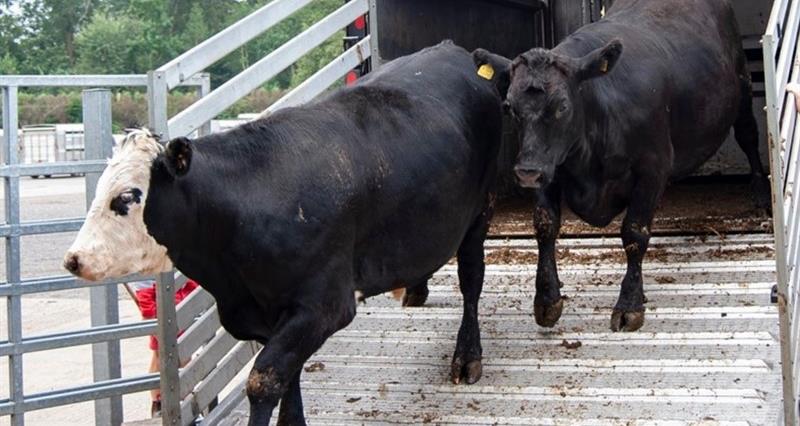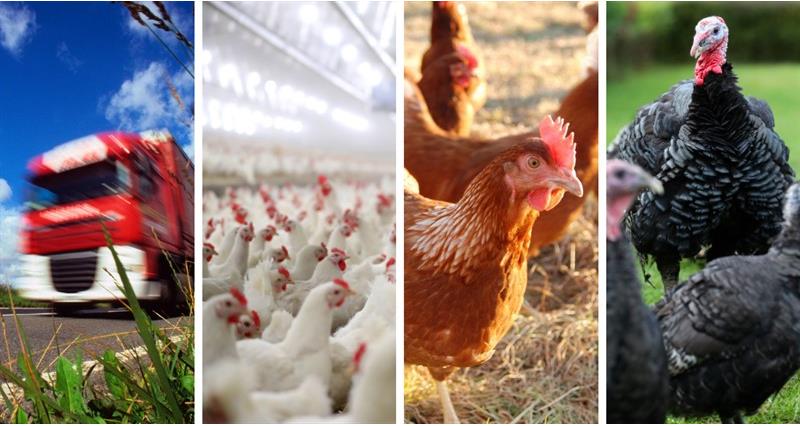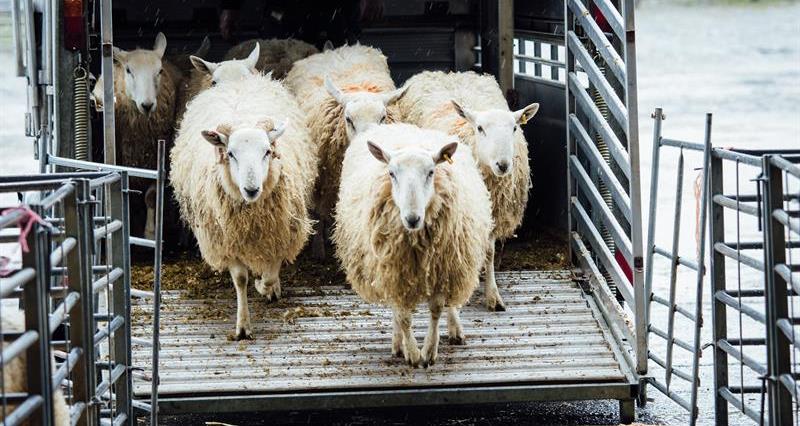In UK law, this means that before transporting, you must check the following:
- your animals, for physical conditions which could cause suffering;
- that the vehicle is in good working order and not an injury risk;
- road and weather conditions will not delay your journey or cause suffering due to extremes of temperature.
Extreme weather
, now clearly instructs transporters not to transport animals when external temperatures are more than 30°C, unless in temperature-controlled vehicles.
Where humidity is also high, the ‘feels like’ temperature on phone/web-based weather tools should be used as an indicator. This means that you should not transport animals above this temperature to avoid the potential suffering because of heat stress.
Whilst this temperature limit is not yet directly written in law, should poor welfare and suffering following transport be identified by a government officer (e.g. at a slaughterhouse), weather conditions and compliance with the guidance will be recorded as part of any non-compliance referral to the authorities.Â
Transporters who do not transport in accordance with the guidance, therefore have significant risk of potential referral for prosecution under Welfare in Transport Law.
NFU position
»Ê¼Ò»ªÈËis still working closely with the wider industry and Defra to ensure proposals for reform to Welfare in Transport law are workable and proportionate to the welfare risk. Nonetheless, it recognises the risk of heat stress in poorly managed journeys during hot weather, and seeks to help members avoid the potential for suffering and risks of non-compliance.
Fitness to travel
By law, in cases of doubt regarding physical conditions and fitness, you must seek advice from your veterinary surgeon and consider alternatives including treatment or on-farm slaughter.
NFU experts explain below what you need to know and look out for when transporting sheep.
When preparing sheep for transport, have you checked for the following?
By law: in cases of doubt, you must seek advice from your veterinary surgeon and consider alternatives including treatment or on-farm slaughter.
Open wounds, flystrike or prolapses
Wounds
If the wound is serious and open, penetrating a body cavity or infected, the animal is not fit for transport. The test is whether the animal is likely to experience additional pain or suffering during transport.
For other wounds you must consider the potential for the wounds to cause pain and blood loss during transport.
Any wound that is actively bleeding and involving the full skin thickness is ‘severe’ at the time and therefore not fit.
Abrasions that don’t involve the full thickness of skin, which have probably occurred during handling prior to transport, are acceptable. Historic surgery and healing large wounds are acceptable providing that all reasonable measures have been taken to prevent the site from being traumatised during transport.
Consider:
- how extensive or/and severe the wound is
- whether there are multiple wounds
- whether the wound is healed or not healed/open
- whether the wound is actively bleeding or infected.
Prolapses
An animal suffering from a prolapse can only be transported in limited circumstances – usually for treatment or slaughter. Before transporting you should seek veterinary advice, and for slaughter make contact and notify the abattoir procurement team and official vet (OV). Additional care may be needed to protect the animal during transport, for example by single penning and deep bedding the animal.
Lameness
To be fit for transport, livestock must be able to walk independently on all four feet, without pain.
Assessing lameness before transport
When deciding whether a lame animal is fit to transport, consider the degree of lameness and the demeanour of the animal.
Animals that are slightly ill or injured can only be transported if the intended journey is not likely to cause any unnecessary suffering or pain, or aggravate the injury, however slightly.
An animal showing signs of lameness is likely to be in pain. If in doubt do not transport the animal or seek veterinary advice.
Transporting lame animals
Whenever a lame animal is transported, the journey conditions will need to be improved.
- Pen the animal individually.
- Ensure the floor provides good footing.
- Provide extra bedding for comfort.
- The driver should take special care to avoid any sudden changes in speed or direction that might throw the animal off balance.
- The animal should have enough space to move with the vehicle and turn around or get back up if they lose their balance.
Disease
Animals should not be transported with signs of active disease processes – they will be at greater risk of poor welfare during transport due to the additional stresses placed upon them and they will also present a biosecurity risk to other animals in the vehicle or at locations en route.
The following signs indicate animals which are unfit for transport – veterinary guidance should be sought to determine the appropriate course of action (there are on-farm emergency slaughter provisions for nervous or aggressive bovines).
The following list will prohibit the transport of any animal with any condition:Â
- causing weight loss (particularly chronic weight loss)
- of the digestive system causing repeated vomiting or diarrhoea
- causing breathing difficulties
- obviously affecting the normal walking of the animal
- that prevents an animal from eating or drinking
- making the animal depressed, nervous or aggressive
- causing wasting (emaciation) or a temperature (fever).
Animals suffering from any infectious disease should not be transported.
Visual impairment
Blind animals are at risk of being injured during transport due to disorientation, fear, and stress. Therefore, blind animals and those with advanced ocular disturbances (ongoing eye conditions eg silage eye, or heavily scarred/clouded eyes) should not be transported.
Animals with a partial visual impairment can also easily become disorientated, scared or stressed and should be transported within their social group.
Eye conditions
Eye disease in sheep can be extremely painful, liable to rupture and impair vision, potentially leading to permanent blindness.
Any animal with an ongoing eye condition should not be transported until the condition has been treated and a full recovery has taken place.
- Periorbital eczema – sheep have severely swollen eyelids which block vision in that eye
- New forest disease/pink eye (Infectious Keratoconjunctivitis) – signs of pink eye include obvious tear staining of the face, forced closure of the eyelids and reddening of the conjunctiva. Animals find it painful to be in direct sunlight. More advanced cases show cloudiness of the surface of the eye and sometimes severe ulceration of the eye surface.
- Silage eye (Ovine Iritis) – initial signs are excessive tear production, forced closure of the eyelids, and aversion to light affecting one or both eyes. Within two to three days, the surface of the eye develops a bluish-white opacity.
Weakness, fatigue or poor body condition
The general condition of the animal is important – it must be ‘fit for the intended journey’.
Animals in poor condition are too weak to be transported as they do not have enough muscle strength. If presented in an abattoir, these animals will be rejected as unfit for human consumption.
Weak animals have less chance to move away from aggression, and are more likely to lose balance, due to sudden stops or acceleration, or changes of direction of the vehicle.
Suspected fractures
An animal known or suspected to have a fracture, in any part of the body, must never be transported.
Fractures are inherently painful, worsened when an animal must stand in a moving vehicle during transport.
The need for animals to constantly adjust their balance during transport and the greater likelihood of the animal slipping or stumbling may cause a fracture to destabilise further, penetrating the skin, paralysing the animal (pelvic or spinal injuries), or causing internal bleeding.
All known or suspected fractures must be slaughtered on-farm (see emergency slaughter on farm).
Physical abnormalities
More care may need to be taken with any animal with a physical abnormality.
They may need additional support such as extra bedding or for their space allowance to be altered. It must be considered whether the abnormality causes additional pain and suffering when the animal is not in its usual environment (eg abnormal gait or lameness) or is likely to be at greater risk of injury during transport (eg large swelling, hernia or deformity).
Animals with long-standing deformities from birth or a young age are also not necessarily fit for transport, simply because it has become accustomed to living with the condition.
In all such cases veterinary advice should be sought to determine whether the animal is fit to transport and can be done so safely.
Pregnancy
Sheep should not be transported if:
- They are pregnant females in the last 10% of pregnancy. Where possible, estimated or actual service or AI dates should be used, but otherwise look for visible signs of advanced pregnancy eg enlarged abdomen, relaxed muscles around the tail head and tissues of the vulva, enlarged udder and swelling on underside of belly (hogging). An average gestation period for sheep is 150 days.
- They have given birth during the last week.
New-born lambs
- New-born lambs should not be transported if their navel has not been completely healed.
- Lambs of less than one week old can only be transported for a maximum of 100km (62 miles). Bedding is a requirement for lambs weighing less than 20kgs.
±õ²Ô²µ°ù´Ç·É¾±²Ô²µÌý³ó´Ç°ù²Ô²õ
Animals with ingrowing horns, or broken and damaged horns that have the internal tissue exposed, are not fit for transport.




